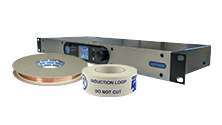In the United Kingdom almost all hearing aids are equipped with a Telecoil, and they are increasing in popularity in the United States where in excess of 60% plus of hearing aids now have an active Telecoil installed – a proportion that is increasing rapidly with almost all new hearing aids featuring the Hearing Loop (or Induction Loop) compatible technology.
Because telecoils are becoming so common; the utilisation of Hearing Loops in transient applications such as help points, intercoms and museum exhibits is a common practice throughout Europe.
Transient applications are situations where a person with a hearing loss may require access to a sound or audio service where background noise or reverberation make it necessary to use an assistive listening system, however, the user is only passing by the point of required use and it may not possible to issue and collect a receiver.
Hearing loops are the only assistive listening solution that is suitable for this application as the potential user is already carrying the receiver – their own hearing aid. They enable the listener to hear by receiving the signal direct to the ear – as long as the hearing aid is fitted with a T-coil the only action required is simply to switch between settings on the hearing aid.
In an application such as a museum, where the users will be freely moving between a multitude of exhibits, assistive listening solutions such as RF which by its nature is a “broadcast medium” can be clumsy and as the user is required to understand & be directed to change frequencies to listen to specific audio feeds from the different exhibits, it is not conducive to a straightforward experience.
As well as benefitting the hearing impaired, the non-hearing impaired can also benefit greatly from properly designed hearing loops in this scenario, as the loop signal can be confined to desired local areas, either by using specially design “low spill” area coverage systems, or localised “counter loop” style loops. Specific audio commentary for each exhibit can be delivered to the end user by the attendee simply moving into that loop area.
The non-hearing impaired user would be provided with a loop- listener which works on the same principal as the T-coil in the hearing aid. Due to this operating principle; as long as the magnetic field of the loop is adequately controlled there is no need to switch frequencies or channels between areas. This noticeably improves the user experience and eliminates the possibility of user error.
In these sorts of applications we would utilise low overspill area coverage systems & local systems to contain the loop signal to a localised area and allow the user to transition seamlessly between exhibits and displays without the need for changing of channels in the receiver.
Another significant benefit of low overspill induction loop systems, is that they provide an opportunity for further future expansion without unnecessary reintegration of technology. For example; if another exhibit was added to a different area within the museum, the field from the existing loop(s) is already localised to the specific area of the current exhibit(s) and therefore no issue with cross talk or addition of more RF channels has to be addressed.
In order for a system like this to work satisfactorily the electromagnetic noise floor must be clear of electromagnetic background noise produced by units such as transformers.
Occasionally people complain that induction loops are noisy when you step outside the looped area. This is not noise produced by the loop but rather, electromagnetic background noise produced by noisy transformers or bad wiring practice within the building, such as live and neutral power being separated by a long distance and forming a loop, causing the signal to noise ratio to be much higher than is acceptable.
In most situations where a buildings electrical wiring is modern and the loop is positioned away from any noisy transformers this noise outside a low overspill loop is too low to notice.
Below is an example of a museum in Liverpool, England, that utilised a combination of localised systems and low overspill induction loops to provide a free moving ‘guided tour’ to its patrons, allowing them to move seamlessly between exhibits without having to conform to a pre meditated tour or change between channels when moving between exhibits.
By Jon Hoskin
Ampetronic System Design Engineer
Content ©Copyright Ampetronic Ltd 2013


